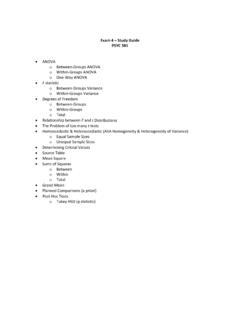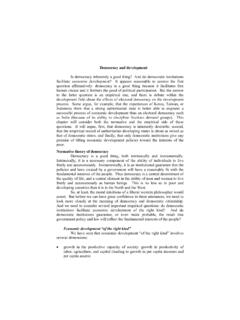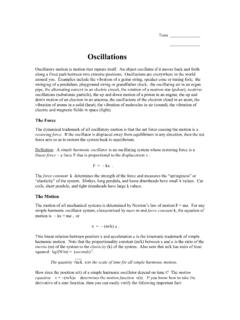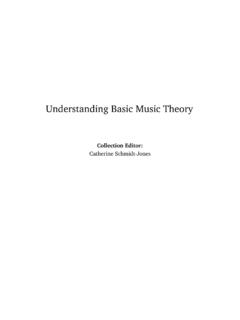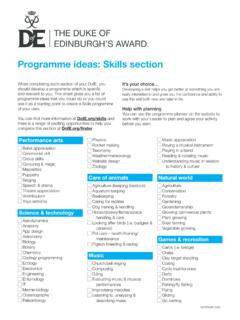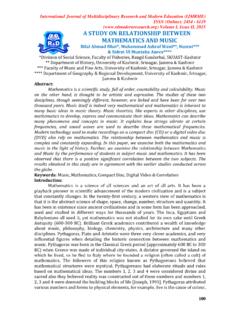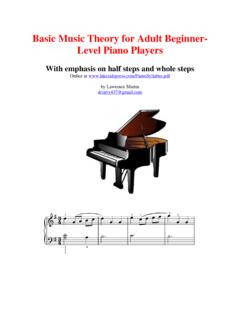Transcription of Waves and Modes
1 Team: Waves and Modes Part I. Standing Waves Whenever a wave (sound, heat, light, ..) is confined to a finite region of space (string, pipe, cavity, .. ) , something remarkable happens the space fills up with a spectrum of vibrating patterns called standing Waves . Confining a wave quantizes the frequency. Standing Waves explain the production of sound by musical instruments and the existence of stationary states (energy levels) in atoms and molecules. Standing Waves are set up on a guitar string when plucked, on a violin string when bowed, and on a piano string when struck. They are set up in the air inside an organ pipe, a flute, or a saxophone. They are set up on the plastic membrane of a drumhead, the metal disk of a cymbal, and the metal bar of a xylophone.
2 They are set up in the electron cloud of an atom and the quark cloud of a proton. Standing Waves are produced when you ring a bell, drop a coin, blow across an empty soda bottle, sing in a shower stall, or splash water in a bathtub. Standing Waves exist in your mouth cavity when you speak and in your ear canal when you hear. Electromagnetic standing Waves fill a laser cavity and a microwave oven. Quantum-mechanical standing Waves fill the space inside carbon nanotubes and quantum computers. A. Modes A mass on a spring has one natural frequency at which it freely oscillates up and down. A stretched string with fixed ends can oscillate up and down with a whole spectrum of frequencies and patterns of vibration. Mass on Spring String with Fixed Ends (mass m, spring constant k) (length L, tension F, mass density ) f2 = 2f1 2nd harmonic f3 = 3f1 3rd harmonic f4 = 4f1 4th harmonic lFundamenta =FL211fmk21f1 = 2f These special Modes of Vibration of a string are called STANDING Waves or NORMAL Modes .
3 The word standing wave comes from the fact that each normal mode has wave properties (wavelength , frequency f), but the wave pattern (sinusoidal shape) does not travel left or right through space it stands still. Each segment ( /2 arc) in the wave pattern simply oscillates up and down. During its up-down motion, each segment sweeps out a loop . All points on the string oscillate at the same frequency but with different amplitudes. Points that do not move (zero amplitude of oscillation) are called nodes. Points where the amplitude is maximum are called antinodes. The mathematical equation of a standing wave is y(x,t) = sin(2 x/ ) cos(2 ft). The shape term sin(2 x/ ) describes the sinusoidal shape of the wave pattern of wavelength . The flip-flop term cos(2 ft) describes the up-down oscillatory motion of each wave segment at frequency f. Each mode is characterized by a different and f.
4 B. Harmonics The simplest normal mode, where the string vibrates in one loop, is labeled n = 1 and is called the fundamental mode or the first harmonic. The second mode (n = 2), where the string vibrates in two loops, is called the second harmonic. The nth harmonic consists of n vibrating loops. The set of all normal Modes {n = 1, 2, 3, 4, 5, .. } is the harmonic spectrum. The spectrum of natural frequencies is {f1 , f2 , f3 , f4 , f5 , .. }. Note that the frequency fn of mode n is simply a whole-number multiple of the fundamental frequency: fn = nf1 . The mode with 3 loops vibrates three times as fast as the mode with 1 loop. Harmonics are the basis of HARMONY in music . The sectional vibrations of a string as one whole, two halves, three thirds, and so on, are very special because these vibrations produce musical tones that sound the most pleasant when sounded together, they represent the most harmonious combination of sounds.
5 This explains the origin of the word harmonic . Exercise: Sketch the 6th harmonic of the string. If the frequency of the 5th harmonic is 100 Hz, what is the frequency of the 6th harmonic? If the length of the string is 3 m , what is the wavelength of the 6th harmonic? A standing wave is a system of fixed nodes (separated by /2) and vibrating loops (frequency f). In short, a standing wave is a flip-flopping sine curve. Node Node Node /2 /2 f 3C. Creating a Mode In general, when you pluck a string, you excite an infinite number of harmonic Modes (we will discuss this later). How do you excite only one of the Modes ? There are three different methods: 1. The Mathematician Method: Sine Curve Initial Condition If you pull each mass element of a stretched string away from equilibrium (flat string) so that the string forms the shape of a sine curve, and then let go, the whole string will vibrate in one normal mode pattern.
6 If you start with any other initial shape one that is not sinusoidal then the motion of the string will be made up of different Modes . Starting out with an exact sine-curve shape is not easy to do you need some kind of fancy contraption. 2. The Musician Method: Touch and Pluck Guitar players and violin players do this all the time. They gently touch the string at one point (where you want the node to be) and pluck the string at another point (antinode) to make a loop . The oscillation (up and down motion) of the plucked loop will drive the rest of the string to form additional equal-size loops which oscillate up and down at the same frequency as the driving loop. 3. The Physicist Method: Resonance If you gently shake (vibrate) the end of a string up and down, a wave will travel to the right (R), hit the fixed end, and reflect back to the left (L). If you shake at just the right resonance frequency one that matches one of the natural frequencies of the string then the two traveling Waves (R and L) will combine to produce a standing wave of large amplitude: R + L = STANDING WAVE.
7 D. Resonance Since RESONANCE is one of the most important concepts in science, we will focus on this method. Resonance phenomena are everywhere: tuning a radio, making music , shattering a crystal glass with your voice, imaging the body with an MRI machine, picking cherries, designing lasers, engineering bridges, skyscrapers, and machine parts, etc. Consider pushing a person in a swing. If the frequency of your hand (periodic driving force) matches the natural frequency of the swing, then the swing will oscillate with large amplitude. It is a matter of timing , not strength. A sequence of gentle pushes applied at just the right time in perfect rhythm with the swing will cause a dramatic increase in the amplitude of the swing. A small stimulus gets amplified into a LARGE response. Experiment: Shake a Slinky , Make a Mode Go into the hallway. Stretch the slinky (in the air, not on the floor) so that its end-to-end length is 4 to 5 m.
8 It is okay if the slinky sags a little. Keep one end fixed. GENTLY shake (vibrate) the other end side-to-side (side-to-side is easier than up-and-down). DO NOT shake with a large Pull Pull Pull Touch Pluck R R+L L 4force or large amplitude. Remember that resonance is all in the timing, not the force! Shake at just the right frequency to produce the two-loop (n = 2) normal mode. When you have tuned into this n = 2 state, take special note: You are now RESONATING with the coil. You and the coil are one ! Your shaking hand is perfectly in-sync with the coil s very own natural vibration. The frequency of your hand matches f2 of the coil. Note how the distance Dhand that your hand moves back and forth is much smaller than the distance Dcoil that the coil moves back and forth. The driven slinky system has the ability to amplify a small input (Dhand) into a large output (Dcoil).
9 This is the trademark of resonance: a weak driving force (hand moves a little) causes a powerful motion (coil moves a lot). Estimate the values of Dhand and Dcoil by simply observing the motions of your hand and the coil when you are resonating with the coil. Compute the Amplification Factor for this driven coil system. Amplification Factor : Dcoil / Dhand = _____ . Part II. music , Guitar, & Fourier One of the most far-reaching principles in theoretical physics is this: The general motion of any vibrating system can be represented as a sum of mode motions. Reducing the complex generic whole into a set of simple harmonic parts provides deep insight into nature. Therefore, normal Modes are important for two reasons: (1) The motion of each mode is SIMPLE , being described by a simple harmonic oscillator (trig) function: cos(2 ft).
10 (2) The set of Modes serves as a BASIS for any kind of wave/vibrational motion: Any Motion = Sum of Mode Motions = Dhand = _____ cm Dcoil = _____ cm + + + + 5100 Hz 200 Hz 300 Hz 100 Hz A. Plucked String = Mixture of Harmonic Parts Suppose you pluck the A-string of a guitar and look closely at the shape of the vibrating string. You will see the fundamental mode (1st harmonic) flip flopping at the rate of about 100 vibrations per second. At such a high frequency, the string looks like one big blurred loop: However, what you see is NOT THE WHOLE PICTURE ! In reality, the string is vibrating with a whole spectrum of normal mode shapes and frequencies all at the same time: 1-loop @ 100 Hz , 2-loop @ 200 Hz , 3-loop @ 300 Hz , 4-loop @ 400 Hz , etc. The actual picture of a plucked string (showing only the first three harmonics) is: It is difficult to see the 2-loop, 3-loop, 4-loop vibrations.

